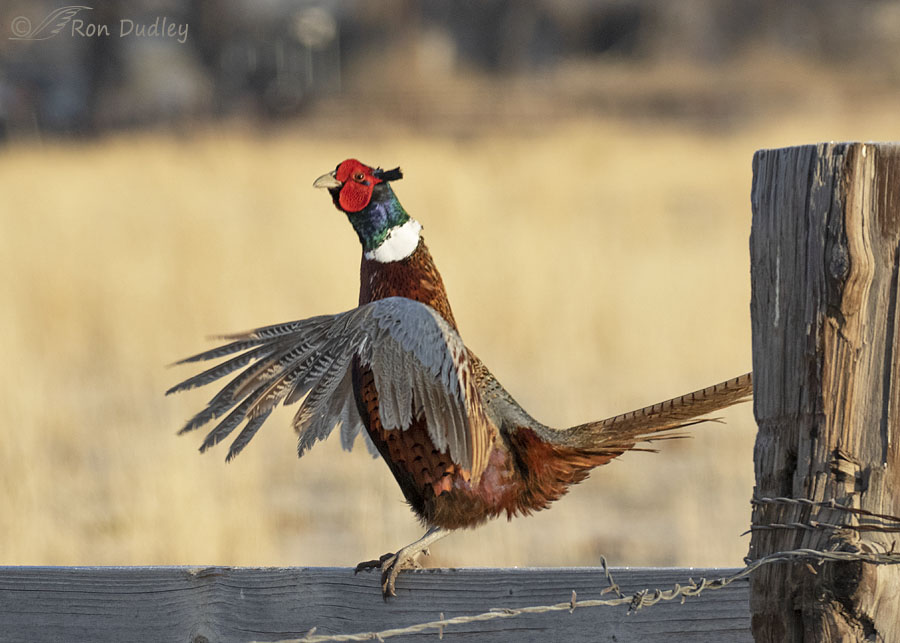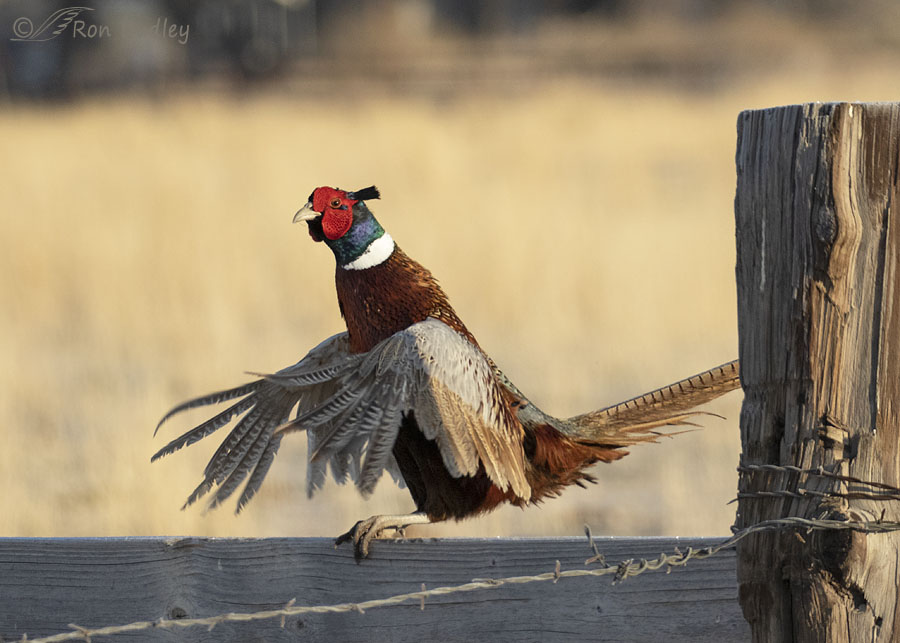Plus some light at the end of the tunnel for this anxious bird photographer.
Yesterday morning, despite being limited to my much smaller lens while my primary birding lens is in the shop for repair, I took a chance and made a long trip to a fairly remote area of Utah in a quest for cooperative birds.

1/1600, f/7.1, ISO 800, Canon 7D, Canon 7D Mark II, Canon EF 100-400mm f/4.5-5.6L IS II USM + 1.4 tc at 299mm, not baited, set up or called in
This male Ring-necked Pheasant was as close as I came to success. I found him perched on a rustic old fence soon after sunrise. Most of the time he was in the shadow of the tall corner fence post at right but during this particular crowing display I got reasonably good light on all of him except for his left wing and the hidden portion of his tail.
To me a rustic setting like this seems perfectly appropriate for a Ring-necked Pheasant. I like the way he’s framed by the post and rail and the warm light on the bird and most of the background. Some viewers won’t appreciate the barbed wire but like it or not that stuff has become an integral part of the rural landscape. Without the wire there wouldn’t be fence posts and rails that a wide range of birds rely on as elevated perches so I’ve learned to become at least a little more tolerant of the wire itself.
That said, next time I come across another critter hung up in the “devil wire” my acceptance of it is likely to take another big hit.

1/1600, f/7.1, ISO 800, Canon 7D, Canon 7D Mark II, Canon EF 100-400mm f/4.5-5.6L IS II USM + 1.4 tc at 299mm, not baited, set up or called in
He looks so beat up from molt I’m not sure what he had to crow about but he must have thought he was a pretty dandy-looking bird because he displayed like this four different times while crowing and flapping his wings. With so many wing feathers missing and still growing in I have to wonder if he could even fly. When he left the fence rail he just hopped down into the grasses and eventually disappeared.
I thought my ‘back-up’ lens performed more than acceptably well in this situation, especially with the teleconverter attached. I don’t expect the image quality from that combination that I get from my 500mm f/4 prime lens when it’s working properly so in this instance I was more than pleased.
Ron
Lens Repair Update:
After some serious and damn-near unforgiveable missteps Canon has pledged that my repaired 500mm prime lens will be back in my grubby little hands no later than Monday or Tuesday of next week. Many of my readers are photographers and all of us need gear repair at some time or another so it’s my intention to report on the saga of my lens repair in more detail sometime soon. The story has pronounced highs and lows and it isn’t over yet.


I hope you have more success with canon then I did
Beat-up or not he is a beauty.
I will cross all my digits that your main lens is back in your anxious hands early next week.
Thanks on both counts, EC.
Very nice and he stayed put long enough for photos. He could also be beat up from fighting for females this time of year, the males can really duke it out!
Yeay, I’ve seen some of their nasty fights. Photographed a couple of them too.
Despite being an introduced species, your bucolic photo certainly makes it look like it belongs. The dried grass provides a nice bokeh and the old gray fence complements the old primaries.
We had a Ring-necked Pheasant who frequented our neighborhood in Logan. That was a strange sight seeing him flying down the middle of the street.
Lyle, I don’t remember for sure if I told you once (I may have) that I used to live in Logan. I lived there while attending USU in 65-66 and again in 67-68. Maybe you and I lived there at the same time. My uncle owned City Drug in Logan, maybe you remember that place.
We were there 92-99. I imagine your uncle’s store was eaten up by the chains by then. You could see the old downtown struggling to survive.
Yes, that’s exactly what happened to his store. When I was there downtown was thriving, as was my uncle’s drug store.
I have photographed pheasants often, and your photo reminded me of what characters they are!
I don’t get to photograph them as often as I’d like. Largely because of urban sprawl our pheasant populations are really struggling.
Ah, such fun to see a crowing pheasant! Thanks, Ron!!!
Good!
He is a dandy fellow in spite of his unkempt appearance. Your baby lens proved more than adequate in this situation. 🙂
I think so too, Marty.
Your marvelous photo shows a sight I’ve never seen–a pheasant crowing. I particularly enjoy photos of behaviors I’ve never seen. I most often see the tails of the very shy pheasants that live near me.
Is your 500mm lens an original or a II? Canon has refused to service my 500mm lens because it is so old. This definitely turned me off on Canon!
Nancy, my 500 is the newer version. Yes, the Canon guy told me on the phone that they no longer service version 1 of that lens. I had the older version but I bought version 2 very soon after it was released nine years ago.
Beautiful even if he is in ratty shape due to molt! 😄 Flushing them accidently ALWAYS has a huge startle factor for me.
“Different” when you’re used to the 500 mm but this lens certainly is no slouch in my opinion.
Sure hope Canon “groups their poop” and gets the properly repaired lens back when they said they would. Will be an interesting(?) story I’m sure.
Thanks, Judy. By yesterday morning I was pretty pissed off at Canon but they’ve now recouped most of my respect.
The back-up lens did really well. Looks sharp and those colors are beautiful. When I was a kid back in Pennsylvania we used to run through the fields making the pheasants fly off, but in all my years with them while growing up I don’t ever recall seeing one perched.
Looking forward to the story of the lens repair.
“we used to run through the fields making the pheasants fly off”
Everett, if you’ve done that I’m sure you’ve unexpectedly flushed pheasants right in front of you. Those explosive and very noisy takeoffs get your attention don’t they!
I really love this bird. Never knew they crowed!!! I always get a thrill on those very rare occasions when I see one.
Arwen, I call it crowing and I think others do too. The gyrations they go through during the process are very similar to those of a rooster chicken. Maybe that’s why they call male pheasants “roosters”.